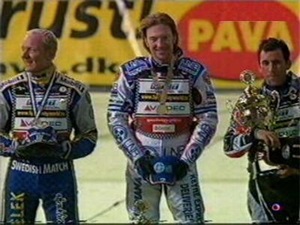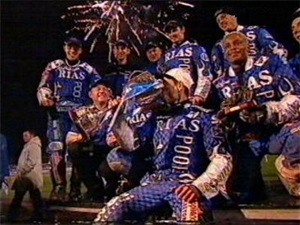
| Home | Contact Us | Articles |
| Books - DVDs | Stadia Pix | Programme Generator |
A Year in Summary : 2004
The Grand Prix

The 2004 series was staged over nine rounds, starting in Stockholm in May 1st and ending in the Viking Ship in Hamar in October. By the end of the campaign Jason Crump had fulfilled his destiny and become speedway champion of the world.
Crump had finished in second place in the previous three years and was more determined than ever to make the title his. He started well by finishing in second place to Leigh Adams in the opening meeting, just ahead of the 'old guard' of Rickardsson and Gollob in third and fourth. Things were looking even better for him when he won the second round in Prague, defeating the impressive Jaroslaw Hampel in the final. After two rounds Crump had 45 points, his nearest challengers were Adams on 38 and Rickardsson on 36.
Hampel maintained his good form in the third round in Wroclaw. The young Pole was again second and began to look like a real contender. That the meeting was won by Bjarne Pedersen was an even greater shock. Crump had a nightmare and left with only eight points, Rickardsson picked up 18 for his third consecutive third place and took the lead by singe point.
The situation was reversed when the GP circus hit Cardiff in June. Rickardsson tumbled out with eight points, while Crump finished fourth to pick up sixteen. The meeting was won by a rejuvenated Greg Hancock who shrugged off his three earlier poor performances to become a rostrum contender. This meeting also marked an unlikely return to the Grand Prix scene for Chris Louis and a decent performance from David Norris.
The fifth round in Denmark saw another victory for Jason Crump and another disastrous round for Tony Rickardsson. Andreas Jonsson finished second, one of only two final appearances for him in 2004, while defending champion Nicki Pedersen finally made a final but could only finish fourth. Pedersen's disappointing campaign saw him eventually finish in fifth position in the series.
Crump and Rickardsson were second and third respectively in the sixth round in Gothenberg. This round saw Hans Andersen firmly establish himself as one of the sport's brightest prospects by clinching victory.
Rickardsson was the victor in the Slovenian round while Jason Crump could only muster 13 points. This left Crump on 127 and Rickardsson on 112. Greg Hancock continued his good run by finishing second, his fourth consecutive final appearance. Hans Andersen and Andreas Jonsson finishing third and fourth respectively.
Crump remained the favourite before the penultimate round in Bydgoszcz but he couldn't afford another poor round. He rose to the occasion by finishing second to home favourite Tomasz Gollob. Rickardsson finished third, for the fifth time in the series, and now trailed Crump by 17 points. The title was now within Jason's grasp as Tony needed to win the final round and hope that Crump had a disaster.
Tony did his part by winning the final round in Hamar, but Crump did enough to clinch the title. He finished on 158, Rickardsson on 155, Hancock on 137 and Adams on 131.
The field for 2005 has been reduced to 15 permanent riders and a wildcard. Other qualifiers are Nicki Pedersen, Tomasz Gollob, Andreas Jonsson, Jarek Hampel, Hans Andersen, Bjarne Pedersen, Lee Richardson, Scott Nicholls and Ryan Sullivan. Biggest name casualties of the reduced lineup are Mikael Max, Mark Loram and the Dryml brothers.
The Elite League

The Elite League was boosted by the inclusion of Arena Essex and Swindon. These clubs moved up from the Premier League to increase the size of the league to 10 clubs. In order to ensure a fair distribution of riders it was necessary to introduce rider gradings instead of a points limit. Both new teams were able to assemble reasonable sides and held their own at Elite League level.
Poole Pirates defended their league title by defeating Wolverhampton in both legs of the play-offs. The Pirates success was remarkable as they lost talisman Tony Rickardsson in April, the Swede deciding to cut back on his racing commitments. Ryan Sullivan, who had left Peterborough during the winter, was brought in to replace Tony but he was never able to replicate Rickardsson's phenomenal scoring.
Much of the Pirates success can be attributed to improvement from Antonio Lindback and Bjarne Pedersen. Lindback started the season at reserve but actually finished top of the averages. Pedersen increased his average and made a heat-leader slot his own. He also tasted individual glory by winning the Elite League Riders Championship, albeit with the benefit of home advantage and an understrength field.
The Pirates also retained the Knock-Out Cup by defeating Peterborough, Swindon and Ipswich in that order. The second leg of the final was staged on the last day of the season.
The only clouds over the Pirates' season were two dismal late season appearances at Oxford and Belle Vue. In both meetings the Pirates failed to make thirty points and, as these meetings were essentially meaningless, there were allegations that they had been 'thrown' in order to reduce the riders' end of season averages.
Biggest losers of the Elite League season were the once proud Coventry Bees. They lost both Lee Richardson and Billy Hamill because of the new grading system and the team they tracked proved to be too weak. The poor Bees managed to win only nine of their thirty six league meetings.
The Premier League
The Hull Vikings leapt from last place in 2003 to the very top of the table in 2004. The Humberside club were now under the sole promotion of Paul Hodder and Eric Boocock was running the club on a day-to-day basis.
Strangely the Vikings started the season poorly and endured a fairly miserable Premier Trophy campaign. However, once the league campaign got going they were virtually unstoppable and lost only five meetings all season, all of those defeats coming away from home.
Their success can be attributed to the all-round strength of their side. Their number one, Magnus Karlsson, finished on an average of 8.62, while their number six, Emiliano Sanchez, clocked up an incredible 7.35 average. Sandwiched in-between were Garry Stead, Paul Thorp, Ross Brady and Emil Kramer.
Credit must also go to number seven - Joel Parsons. Parsons was bought from Rye House early in the season for a sum rumoured to be in the five figures. His steady contributions from reserve earned him an average in excess of five points and made a significant contribution to the team's success.
For good measure the Vikings also clinched the K.O.Cup and the Young Shield, giving them a treble that looked highly improbable in the early weeks of the season.
The Vikings nearest challengers in the league were Workington and Reading. Interestingly both of these teams favoured a more top-heavy approach to their team building and tracked the formidable Stead/Stonehewer and Bird/Zagar partnerships respectively.
At the other end of the table there were poor seasons for Newcastle and Newport. Newcastle's campaign was in turmoil before they even raced their first meeting. High profile signing Matej Ferjan was deemed to be ineligible to ride in the Premier League. As a result the Diamonds gambled on bringing in Mario Jirout but the Czech failed to find any kind of form and was sacked. The Diamonds were able to bring in Jason Lyons later in the season and he proved to be a tremendous success, unfortunately it was too little too late.
Newport's campaign was simply dreadful and they managed only 17 points from their 28 meetings. Sadly it seems as if some of the enthusiasm that typified the early years of the Wasps renaissance has started to fade.
The Conference League
As in the 'professional' leagues, one team proved to be head and shoulders above the rest in the Conference League also. That team was the Mildenhall Fen Tigers.
The Fen Tigers started the season in fine fettle and harboured ambitions of 'doing an Arsenal' and going through the entire season unbeaten. They didn't quite manage that, although they were only beaten three times in their league campaign and three times in their Conference Trophy campaign.
Ritchie Hawkins, the British Under 21 champion, led the way for the Fen Tigers and was strongly backed by Jon Armstrong, James Brundle, Jason King and Paul Lee. Both Hawkins and Lee were later recruited for Premier League duty on the back of their impressive performances for Mildenhall. Full credit to Graham Drury for rescuing these young riders from the metaphorical 'scrapheap'.
Sadly, the season ended in controversy when the Cup Final between Mildenhall and Boston was completed in less than ideal circumstances. Poor track conditions led to Boston walking out and the Fen Tigers raced the remaining heats against no opposition. A complete disaster for the image of the sport and a sad note for Graham Drury to finish on, he has now moved on to promote Workington.
Elsewhere in the Conference there was much to be pleased about. Riders like Paul Cooper, Steve Boxall, Craig Branney and Chris Mills made good progress and should be well placed to develop long lasting and successful careers in the sport. We saw the sport continue in 'difficult' venues like Wimbledon and Carmarthen, and the re-introduction of the sport to Weymouth proved to be a success. Let's hope Scunthorpe can follow suit next season.